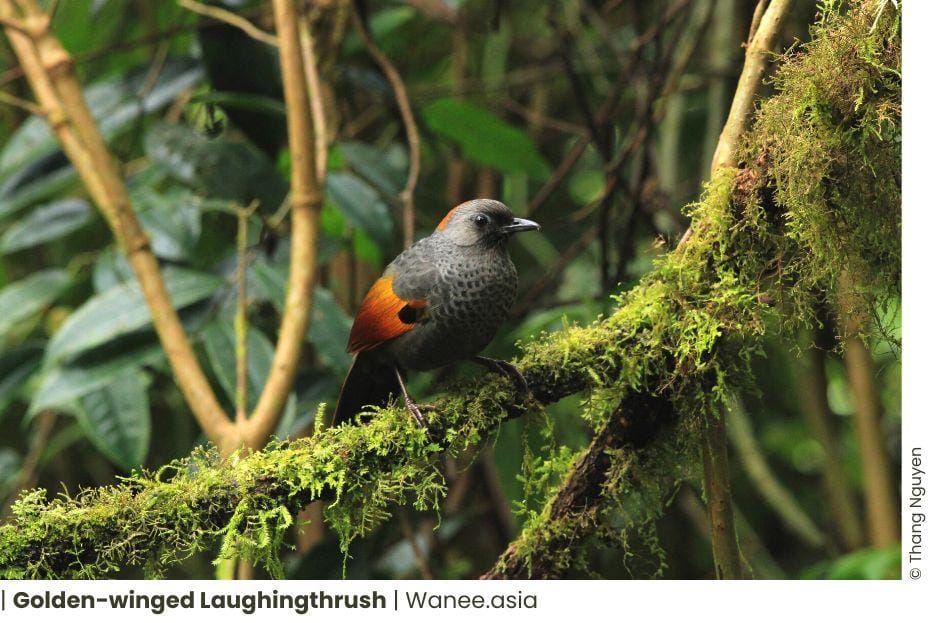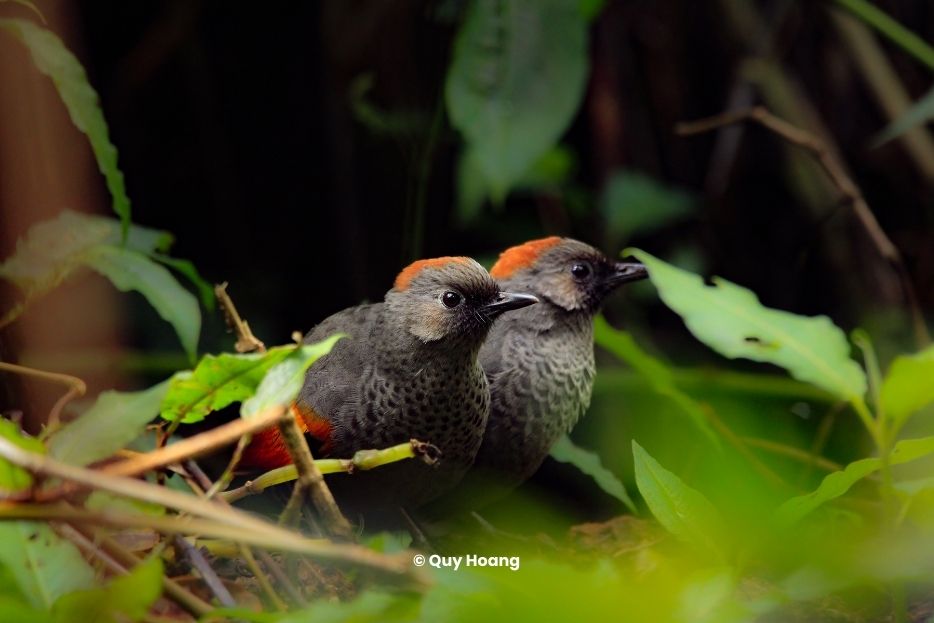Identification of Golden-winged Laughingthrush
The Golden-winged Laughingthrush is a striking bird, primarily gray with distinctive golden and rusty patches on its wings and tail. The darker centers on the feathers of its breast and back give it a delicately scalloped appearance, adding to its unique charm. This species also sports a chestnut crown and nape, with black lores and gray ear-coverts. Its olive-brown tail and golden-brown outer webs make it unmistakable in its natural habitat.
Distinctive Features:
The Golden-winged Laughingthrush is highly distinctive and unlikely to be confused with other species, especially given its limited range and specific habitat preferences. The combination of its golden wings, chestnut crown, and scalloped gray breast sets it apart from other laughingthrushes. It is most similar to G. yersini (Orange-breasted Laughingthrush), but can be easily differentiated by its golden wings and gray mantle.

Habitat Preferences:
Restricted to high-elevation forests above 2,000 meters in the Annamite Mountains of central Vietnam, this species is typically found in the dense shrub and herb layers of primary, upper montane evergreen forests. It is a resident species and has been recorded at elevations as low as 1,480 meters, though it is most commonly observed at higher altitudes.
Behavioral Traits:
The Golden-winged Laughingthrush forages singly or in pairs and is often seen in thick vegetation, making it a challenge to spot. It may occasionally be found in flocks with Red-tailed Laughingthrushes. The bird is known for its two-part meowing call, which can be heard echoing through the montane forests.

Challenges and Conservation Status:
This species is currently listed as Endangered due to its very small range and the ongoing threats of habitat degradation and trapping. The population is estimated to be between 1,500 to 4,000 individuals, and it continues to face pressure from habitat loss and hunting.
More detail on this datazone of Birdlife.
Habitat and how to look for that
How to Look for It:
To successfully observe the Golden-winged Laughingthrush, it’s crucial to be patient and attentive to its habitat. Look for the bird in the understory of evergreen forests, particularly in areas with thick shrub layers. Early morning is the best time to search, as the birds are more active during this time. Listening for its unique meowing call can guide you to its location. Since the bird blends well with its surroundings, a careful scan of the underbrush and ground level is essential.
Best Seasons to Spot:
The Golden-winged Laughingthrush can be observed year-round in its restricted range. However, the best chances to spot it are during the dry season, which typically runs from December to April. During this time, the weather conditions are more favorable for birdwatching, and the birds are more likely to be active. Late April to early May may be less ideal as the birds become quieter, making them harder to detect.
Sound Track
Note: Due to the decline of this species in Vietnam, largely caused by hunting with the use of recorded sounds, we are unable to share its call in this post. Unfortunately, the Golden-winged Laughingthrush is becoming increasingly rare in Vietnam, and we must take precautions to protect it.
Top 2 Locations to Spot the Golden-winged Laughingthrush
1. Mang Den – Mang Canh
- Specific Areas/Trails: This location, while having some records of the Golden-winged Laughingthrush, is considered extremely challenging for spotting the species. Birdwatchers need to explore dense, high-elevation forests with persistence, often requiring early morning starts and long hours in the field.
- Habitat Details: The area consists of high-elevation evergreen forests that provide the dense ground and shrub cover preferred by this elusive bird. It’s essential to focus on areas with thick vegetation where the bird might forage or rest.
- Best Times for Observation: Early morning is generally the best time, though the species is notoriously difficult to spot at any time.
- Challenges: The terrain is rugged, and the bird’s cryptic behavior makes it hard to detect. Additionally, weather conditions can be unpredictable, adding to the difficulty of sightings.
- Tips for Success: Patience and a good understanding of the bird’s calls are key. Staying alert for its meowing call can lead to a sighting, even if the bird itself remains hidden in dense foliage.
2. Mt. Ngoc Linh and Mt. Ngoc Boc
Tips for Success: Thorough knowledge of the bird’s vocalizations is essential. Target areas where mixed flocks of birds are present, as the Golden-winged Laughingthrush may sometimes associate with them.
Specific Areas/Trails: These mountains, located on the Kon Tum plateau of central Vietnam, are the only known locations for the Golden-winged Laughingthrush. Sightings have been recorded in the Ngoc Linh (Kon Tum) Nature Reserve and the proposed Ngoc Linh (Quang Nam) Nature Reserve.
Habitat Details: The species is found in upper montane evergreen forests, typically above 2,000 meters. The forests here are characterized by dense herb and shrub layers, which provide critical cover for the bird.
Best Times for Observation: Like Mang Den, early morning is ideal, but the challenging environment means that sightings are rare at any time.
Challenges: The species’ limited range and the degradation of its habitat make it one of the most difficult birds to observe in the region. The forest’s dense vegetation and the bird’s secretive nature add to the challenge.
Encounter count on this page click on.
Tour include the chance to spot the Golden-winged Laughingthrush
See below or click to go straight
How to Identify the Greater Sand Plover, Tibetan Sand Plover and Siberian Sand Plover
ContentsIdentification of Golden-winged LaughingthrushHabitat and how to look for thatSound TrackTop 2 Locations to Spot [...]
Highlights of Cat Tien National Park Reptiles and Amphibian Endemics
Spanning over 71,350 hectares of tropical forests, grasslands, and wetlands, Cat Tien National Park is [...]
Highlights of Cat Tien National Park Mammals in a World Biosphere Reserve
In addition to reptiles and birds, Cat Tien National Park is also rich in mammals, [...]
Kontum Plateau Endemic and Highlight bird
Kontum Plateau Endemic And Highlight Bird species like Chestnut-eared Laughingthrush and top birding routes while [...]
Dalat Plateau Endemic and highlight bird
The Dalat Plateau is a birdwatcher’s paradise, renowned for its exceptional biodiversity and unique highland [...]
Cat Tien National Park Endemic and Highlighted Birds
Covering 71,920 hectares in southern Vietnam, Cat Tien National Park is home to a number [...]